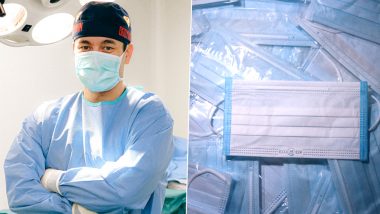London, May 23: Researchers have found under which conditions and in which ways, masks actually reduce individual and population-average risks of being infected with COVID-19 and help mitigate the coronavirus pandemic.
The study, led by researchers from the Max Planck Institute for Chemistry in Germany's Mainz, showed that in most environments and situations, even simple surgical masks effectively reduce the transmission of SARS-CoV-2 and the effective reproduction number for COVID-19. Karnataka Doctor Refuses to Wear Face Mask at Supermarket, Booked After Video Goes Viral
"For the airborne transmission of SARS-CoV-2, we find that usually just a minor fraction of exhaled respiratory particles contains viruses. Most environments and contacts are under virus-limited conditions, where face masks, including simple surgical masks, have a high efficacy in preventing the spread of COVID-19," said Yafang Cheng, the head of the Minerva Research Group at Max Planck.
In environments with potentially high airborne virus concentrations such as medical settings and densely-occupied indoor spaces, masks with higher filtration efficiency (N95/FFP2) should be used and combined with other protective measures such as intensive ventilation. In most situations, even simple surgical masks are effective.
"The combination of high-efficiency masks with other protective measures is particularly important for hospitals, medical centres, and other indoor environments, where high risk patients may encounter high virus concentrations," said Christian Witt, head of the Research Area Pneumology at the Charite Universitatsmedizin Berlin.
"Masks will remain an important protective measure against SARS-Cov-2 infection -- even for vaccinated persons, especially when the protection provided by vaccination decreases over time," Witt said.
For the study, published in the journal Science, the team used observational data and a novel quantitative model of airborne virus exposure to elucidate how the efficacy of face masks depends on characteristic regimes of airborne virus concentration.
The approach can be used to assess protection against more infectious mutants of COVID-19. It is also applicable to a wide range of respiratory viruses and diseases, including coronaviruses, rhinoviruses, and influenza.
The findings showed that aerosol transmission does not necessarily lead to very high reproduction numbers as observed for measles, and that relatively low reproduction numbers do not rule out airborne transmission.
(The above story first appeared on LatestLY on May 24, 2021 01:12 PM IST. For more news and updates on politics, world, sports, entertainment and lifestyle, log on to our website latestly.com).













 Quickly
Quickly


